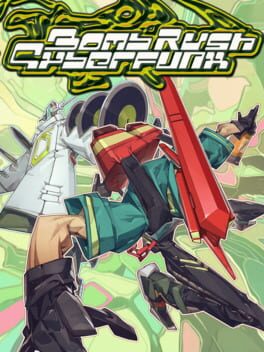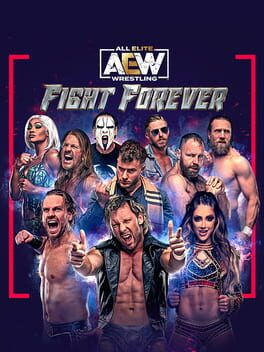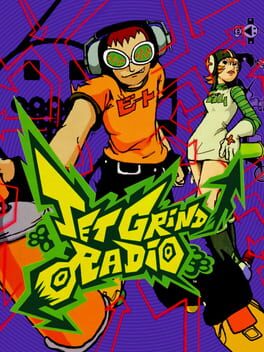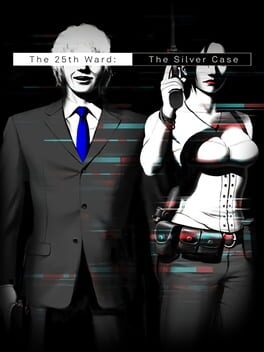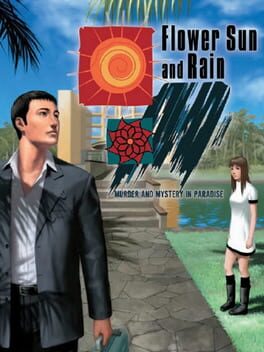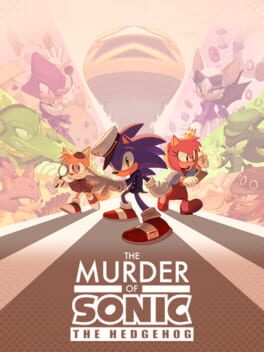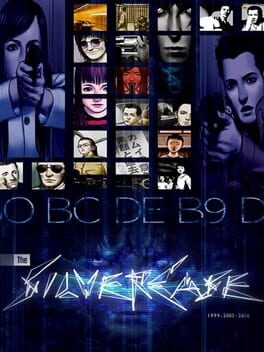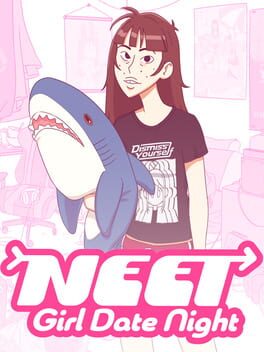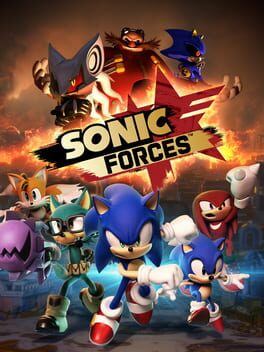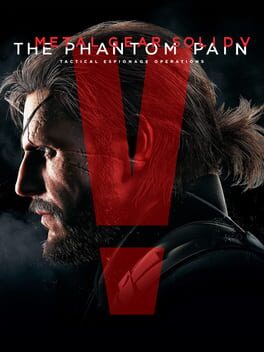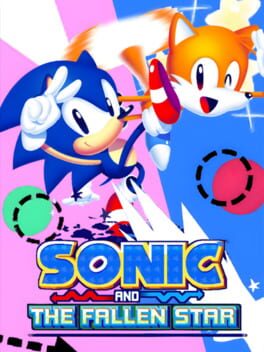handsomezack
2023
Of the handful of attempts various indie devs have made at creating a spiritual successor to the Jet Set Radio series, Team Reptile is the first one to get it right with Bomb Rush Cyberfunk. The game was probably my most anticipated game of 2023, and it definitely delivered. It really does feel like you’re playing a sequel to Jet Set Radio Future. I’ll mainly be comparing it to Future, as the original Jet Set/Grind Radio is a much different type of game, focusing on arcadey levels and high scores rather than a fast-paced interconnected world that encourages exploration.
BRC excels in some places compared to JSRF. There are some excellent ideas that made their way into this game that JSRF would have definitely benefited from. That being said, BRC also comes up short in other areas, so I’m going to pick apart the game piece by piece and give my thoughts regarding how it stacks up in each section.
I’ll start with the gameplay. The level design can be somewhat overwhelming at first, but once you start familiarizing yourself with the locations the game has to offer, they’re excellently designed. It’s immensely satisfying to discover how the levels link each area within them together through rails, billboards, street lamps, and so on in order to chain together massive trick combos and maximize your speed as you grind through each location.
The game has four different ways to traverse its world. Walking/running, skateboarding, roller skating, and biking. Walking/running borders on being completely useless. Apparently freerunning was originally going to be a big focus in the game, with Soap Shoes (or Sonic the Hedgehog) style rail grinding, but in the final game you instead immediately switch to your board/skates/bike when connecting with a rail. I think keeping this focus would’ve been a benefit, as there’s very little reason to walk unless you’re trying to stop somewhere without your momentum carrying you past where you’re trying to stop, or if you want to fight the cops that are chasing you (which is possible while skating/biking, and not really worth it anyway when you could just ride away from them). It would’ve given players a way to mix up the gameplay and offer unique ways to move, but instead it just comes across as annoying when the game forces you to stop rolling around on wheels in order to go up steps or slide through a vent. On a similar note, there’s literally no difference between skateboards, inline skates, and BMX bikes beyond the tricks you can do looking visually different. The same goes for each playable character, which contrasts with the different weights and momentums of each different character in the Jet Set Radio games. I guess this lets you play as the ones you like instead of incentivizing playing as the “best” one, but I feel BRC could have used ways to mix up how the movement felt, because there’s little reason to switch between movement methods. The movement itself is great, being fun and easy to get used to, though it’s much tighter and less momentum-based than either JSR game. This could be a good or bad thing depending on who you ask, and I’m not sure where I stand on it myself, as the clunkier gameplay of JSR can potentially be difficult to get used to, but much more satisfying to master.
The graffiti system, however, is undeniably better than either JSR game. Rather than spending time inputting several strings of joystick inputs like JSR, or simply pressing a button to immediately spraypaint a mural like in JSRF, BRC finds the perfect middle ground and has you essentially connecting dots with quick joystick inputs similar to drawing a star. It’s fast, stylish, and enjoyable. There are dozens of combinations based on which dots you connect first, offering you a giant library of art to paint at any time as opposed to having to lock in a choice of one piece of artwork for each canvas size as you would in the JSR games. It’s without a doubt the biggest improvement BRC has made over the games it was inspired by.
The story was a pleasant surprise. It’s nothing groundbreaking, and the (honestly pretty fun) plot twists are revealed in the fairly boring way of the main character randomly remembering pieces of his backstory as you beat each boss. You get to play some extremely fun dream levels for each fragment of memory though, which is really cool. It’s more than JSR/JSRF did, where the characters aren’t any deeper than a sentence or two describing them in the manual, and the story can entirely be boiled down to “the cops are corrupt, the rich are corrupt, we have to stop their evil plan” which, despite being a message I agree with, is not expanded upon. BRC is a much shorter game than either, which is unfortunate, but it uses its time much more efficiently to tell more of a story. The ending does feel a bit rushed though. I didn’t even know I was in the final area of the game until the final boss (whose first phase was recycled from earlier in the game) came out of nowhere. Room for improvement, definitely, but overall I don’t have much to complain about.
Visually, BRC is exactly what you’d expect from a JSRF sequel. The graphics and art style mimic it almost perfectly. Most JSR-esque games fail to capture the same aesthetic, but BRC hits the nail on the head. I do think the character designs are a little weaker than the original JSR, with Red, Bel, Vinyl, and Solace being the only ones to really stand out. I think like 75% or so of the JSRF redesigns were terrible though, so it’s got a leg up on Future in that regard.
The soundtrack is excellent, but I can’t say I prefer it to JSRF’s soundtrack. The pool of songs is smaller, the transitions between songs aren’t as good, and I felt a few of the songs don’t fit the vibe of the game as well as they should. This is largely down to personal preference though, and easily defendable by the fact that JSRF was made with a triple A budget. Hideki Naganuma is at his best here though, as his three songs included in BRC are leagues above the already phenomenal work he’s done in prior games.
The postgame is more or less the same as JSRF’s postgame, where there isn’t a whole lot to do beyond unlocking the rival characters and finding any collectibles you missed. There are a lot more collectibles though, and ones that I feel are more worth your while. Rather than JUST new graffiti, you also can find new “outfits” (color schemes) for your characters, as well as CDs that allow you to play specific songs whenever you want rather than having to wait for them to come on depending on which location you’re in. A lot of side characters are also easily missable or outright unobtainable until you beat the game, compared to JSRF where you’ll have most if not all of them by the time you beat the final boss. Being rewarded with a final unlockable character for tagging every graffiti spot is also a plus, as JSRF had no reward for doing so. A new game plus option would’ve been nice though, so you actually have something to do with him.
Watching the modding scene grow has also been a lot of fun. Now that I’m in the postgame, I’ve been playing as JSRF's Gum and MF DOOM and listening to a lot of my own music that I feel fits the game’s aesthetic. Not really relevant to my review of the game itself, but still something I wanted to add.
In conclusion, Bomb Rush Cyberfunk will most likely end up being my GOTY. It’s not perfect, and I don’t know if I’d recommend it over Jet Set Radio Future in a one-or-the-other scenario, but not being perfect doesn’t mean it isn’t still an incredible game. I thoroughly enjoyed it from start to finish, and encourage anyone reading this to check it out if you haven’t already. Team Reptile has yet to make a game I haven’t loved, and I’m eager to see where they go from here.
BRC excels in some places compared to JSRF. There are some excellent ideas that made their way into this game that JSRF would have definitely benefited from. That being said, BRC also comes up short in other areas, so I’m going to pick apart the game piece by piece and give my thoughts regarding how it stacks up in each section.
I’ll start with the gameplay. The level design can be somewhat overwhelming at first, but once you start familiarizing yourself with the locations the game has to offer, they’re excellently designed. It’s immensely satisfying to discover how the levels link each area within them together through rails, billboards, street lamps, and so on in order to chain together massive trick combos and maximize your speed as you grind through each location.
The game has four different ways to traverse its world. Walking/running, skateboarding, roller skating, and biking. Walking/running borders on being completely useless. Apparently freerunning was originally going to be a big focus in the game, with Soap Shoes (or Sonic the Hedgehog) style rail grinding, but in the final game you instead immediately switch to your board/skates/bike when connecting with a rail. I think keeping this focus would’ve been a benefit, as there’s very little reason to walk unless you’re trying to stop somewhere without your momentum carrying you past where you’re trying to stop, or if you want to fight the cops that are chasing you (which is possible while skating/biking, and not really worth it anyway when you could just ride away from them). It would’ve given players a way to mix up the gameplay and offer unique ways to move, but instead it just comes across as annoying when the game forces you to stop rolling around on wheels in order to go up steps or slide through a vent. On a similar note, there’s literally no difference between skateboards, inline skates, and BMX bikes beyond the tricks you can do looking visually different. The same goes for each playable character, which contrasts with the different weights and momentums of each different character in the Jet Set Radio games. I guess this lets you play as the ones you like instead of incentivizing playing as the “best” one, but I feel BRC could have used ways to mix up how the movement felt, because there’s little reason to switch between movement methods. The movement itself is great, being fun and easy to get used to, though it’s much tighter and less momentum-based than either JSR game. This could be a good or bad thing depending on who you ask, and I’m not sure where I stand on it myself, as the clunkier gameplay of JSR can potentially be difficult to get used to, but much more satisfying to master.
The graffiti system, however, is undeniably better than either JSR game. Rather than spending time inputting several strings of joystick inputs like JSR, or simply pressing a button to immediately spraypaint a mural like in JSRF, BRC finds the perfect middle ground and has you essentially connecting dots with quick joystick inputs similar to drawing a star. It’s fast, stylish, and enjoyable. There are dozens of combinations based on which dots you connect first, offering you a giant library of art to paint at any time as opposed to having to lock in a choice of one piece of artwork for each canvas size as you would in the JSR games. It’s without a doubt the biggest improvement BRC has made over the games it was inspired by.
The story was a pleasant surprise. It’s nothing groundbreaking, and the (honestly pretty fun) plot twists are revealed in the fairly boring way of the main character randomly remembering pieces of his backstory as you beat each boss. You get to play some extremely fun dream levels for each fragment of memory though, which is really cool. It’s more than JSR/JSRF did, where the characters aren’t any deeper than a sentence or two describing them in the manual, and the story can entirely be boiled down to “the cops are corrupt, the rich are corrupt, we have to stop their evil plan” which, despite being a message I agree with, is not expanded upon. BRC is a much shorter game than either, which is unfortunate, but it uses its time much more efficiently to tell more of a story. The ending does feel a bit rushed though. I didn’t even know I was in the final area of the game until the final boss (whose first phase was recycled from earlier in the game) came out of nowhere. Room for improvement, definitely, but overall I don’t have much to complain about.
Visually, BRC is exactly what you’d expect from a JSRF sequel. The graphics and art style mimic it almost perfectly. Most JSR-esque games fail to capture the same aesthetic, but BRC hits the nail on the head. I do think the character designs are a little weaker than the original JSR, with Red, Bel, Vinyl, and Solace being the only ones to really stand out. I think like 75% or so of the JSRF redesigns were terrible though, so it’s got a leg up on Future in that regard.
The soundtrack is excellent, but I can’t say I prefer it to JSRF’s soundtrack. The pool of songs is smaller, the transitions between songs aren’t as good, and I felt a few of the songs don’t fit the vibe of the game as well as they should. This is largely down to personal preference though, and easily defendable by the fact that JSRF was made with a triple A budget. Hideki Naganuma is at his best here though, as his three songs included in BRC are leagues above the already phenomenal work he’s done in prior games.
The postgame is more or less the same as JSRF’s postgame, where there isn’t a whole lot to do beyond unlocking the rival characters and finding any collectibles you missed. There are a lot more collectibles though, and ones that I feel are more worth your while. Rather than JUST new graffiti, you also can find new “outfits” (color schemes) for your characters, as well as CDs that allow you to play specific songs whenever you want rather than having to wait for them to come on depending on which location you’re in. A lot of side characters are also easily missable or outright unobtainable until you beat the game, compared to JSRF where you’ll have most if not all of them by the time you beat the final boss. Being rewarded with a final unlockable character for tagging every graffiti spot is also a plus, as JSRF had no reward for doing so. A new game plus option would’ve been nice though, so you actually have something to do with him.
Watching the modding scene grow has also been a lot of fun. Now that I’m in the postgame, I’ve been playing as JSRF's Gum and MF DOOM and listening to a lot of my own music that I feel fits the game’s aesthetic. Not really relevant to my review of the game itself, but still something I wanted to add.
In conclusion, Bomb Rush Cyberfunk will most likely end up being my GOTY. It’s not perfect, and I don’t know if I’d recommend it over Jet Set Radio Future in a one-or-the-other scenario, but not being perfect doesn’t mean it isn’t still an incredible game. I thoroughly enjoyed it from start to finish, and encourage anyone reading this to check it out if you haven’t already. Team Reptile has yet to make a game I haven’t loved, and I’m eager to see where they go from here.
It's the only wrestling game where you can play as Eddie Kingston, so it's automatically a good game.
Kinda lacking in content for now, but the gameplay is extremely fun and easy to learn. Definitely not a perfect game, but enjoyable enough that it'll likely be my go-to for the forseeable future when I want to play a wrestling game.
Kinda lacking in content for now, but the gameplay is extremely fun and easy to learn. Definitely not a perfect game, but enjoyable enough that it'll likely be my go-to for the forseeable future when I want to play a wrestling game.
2000
With Bomb Rush Cyberfunk around the corner, I figured I owed both JSR games a replay. I've played through this one twice before, once on PS3 and once on PC, but since I own a Dreamcast I figured I'd play it on my CRT this time.
I think the "bad controls" that I'm seeing in other reviews and hearing elsewhere online are a little overstated. It's probably been a decade since I last played JSR, and this replay made me realize the game is certainly rough around the edges and takes some getting used to. Your momentum can often work against you and the camera controls are downright terrible (in the Dreamcast version; the PC/PS3/360 ports let you use the other analog stick to control the camera). That being said, it didn't take long for me to get the hang of things and start having a blast with the game. The music, art style, and general aesthetics are just as good as everyone says. In some ways I'd say they're better than Jet Set Radio Future, despite Future being an overall improvement and better game. The arcadey gameplay loop is fun and very replayable. I can see myself starting a NG+ in the near future to go back and collect all the graffiti souls and secret characters while I wait to replace my dead Xbox in order to replay Future. JSR is everything I love about 90s Sega arcade games, despite it technically not being one. If you stumbled upon this review and haven't played it, definitely give it a shot. I'd just recommend playing it on PC if you're not someone like me who's willing to deal with the flaws of the original for the sake of actually playing on the Dreamcast. The few missing music tracks from the port really aren't worth the tradeoff of the original's camera controls.
I think the "bad controls" that I'm seeing in other reviews and hearing elsewhere online are a little overstated. It's probably been a decade since I last played JSR, and this replay made me realize the game is certainly rough around the edges and takes some getting used to. Your momentum can often work against you and the camera controls are downright terrible (in the Dreamcast version; the PC/PS3/360 ports let you use the other analog stick to control the camera). That being said, it didn't take long for me to get the hang of things and start having a blast with the game. The music, art style, and general aesthetics are just as good as everyone says. In some ways I'd say they're better than Jet Set Radio Future, despite Future being an overall improvement and better game. The arcadey gameplay loop is fun and very replayable. I can see myself starting a NG+ in the near future to go back and collect all the graffiti souls and secret characters while I wait to replace my dead Xbox in order to replay Future. JSR is everything I love about 90s Sega arcade games, despite it technically not being one. If you stumbled upon this review and haven't played it, definitely give it a shot. I'd just recommend playing it on PC if you're not someone like me who's willing to deal with the flaws of the original for the sake of actually playing on the Dreamcast. The few missing music tracks from the port really aren't worth the tradeoff of the original's camera controls.
When I first started playing The 25th Ward, I wasn’t sure how to feel. After a very good opening chapter, things quickly slowed down and I was having trouble taking in what the game was telling me. The Silver Case had me playing alternating chapters between two perspectives that, while unique, focused on the same overall plot. Any confusion I had regarding the new information I learned was always cleared up via the next chapter retreading what I’d played and beating the information into me. The 25th Ward, however, now has THREE alternating chapters, none of which are as closely tied together as the two Silver Case routes were. At one point early on, I began to question my feelings toward the game. And then I played the next chapter and suddenly everything clicked. The plot quickly started picking up and I immediately fell in love with the game. The character writing is among the best you’ll find in the Kill The Past series, and it’s backed up by a story that gets more and more interesting the further you progress. After a certain point I found it hard to resist binging the game, and was making my way through several chapters a night. Each chapter delved deeper and deeper into the main character of each of the three routes, offering a lot of insight and intrigue regarding their stories and invoking much more sympathy than previous games in the series.
By the end I had very few complaints, the biggest one being that I wish we would’ve gotten to see more of the returning characters from The Silver Case and Flower, Sun, and Rain that I’d grown to love. The other is the gameplay itself. The game has some annoyingly opaque trial and error puzzles that leave you with little option other than to waste a lot of time guessing, or otherwise consult a guide. It also can’t seem to escape its roots as a mobile game, as movement in this game has been reduced to choosing an option for whichever directions are available to you, a big downgrade from The Silver Case’s movement system, which was reminiscent of a first person dungeon crawler. These complaints are all fairly minor though, and don’t take much (if any) away from my pleasant experience with the game.
In conclusion, this game is excellent (as were the two that came before it) and something I’m looking forward to revisiting in the future. I imagine there’s a lot of foreshadowing and small details that went over my head. There’s plenty of room to continue, so now all that’s left is for me to sit here hoping Goichi Suda’s plans for The 26th Ward eventually come to fruition.
By the end I had very few complaints, the biggest one being that I wish we would’ve gotten to see more of the returning characters from The Silver Case and Flower, Sun, and Rain that I’d grown to love. The other is the gameplay itself. The game has some annoyingly opaque trial and error puzzles that leave you with little option other than to waste a lot of time guessing, or otherwise consult a guide. It also can’t seem to escape its roots as a mobile game, as movement in this game has been reduced to choosing an option for whichever directions are available to you, a big downgrade from The Silver Case’s movement system, which was reminiscent of a first person dungeon crawler. These complaints are all fairly minor though, and don’t take much (if any) away from my pleasant experience with the game.
In conclusion, this game is excellent (as were the two that came before it) and something I’m looking forward to revisiting in the future. I imagine there’s a lot of foreshadowing and small details that went over my head. There’s plenty of room to continue, so now all that’s left is for me to sit here hoping Goichi Suda’s plans for The 26th Ward eventually come to fruition.
Sumio must have calves of steel after all the walking he does in this game.
Flower, Sun, and Rain might be one of the most unique games I've played. Spending copious amounts of time doing nothing but walking back and forth between distant locations, solving esoteric math equations... None of that sounds like fun, and yet I loved every minute I spent with this game. While I'm not too crazy about all the puzzles being number-based (I'll admit I found myself having to consult a guide at times), the way the game handles them by technically having the solution to every single one of them on the player at all times is brilliant. The monotonous gameplay loop of slowly getting closer and closer to your original destination each day is oddly exciting, and once I started making serious progress I found myself unable to put the game down. The simple early-game tasks the player is presented with evoke a sense of comfort, which is quickly ripped away once the plot threads start unravelling and the truth of the island you've been walking around on starts becoming more apparent. Many of the big reveals in the game left me genuinely surprised. Some confusion is inevitable, but the links the game has to The Silver Case become very clear. This didn't stop when I finished the game, as dwelling on what I'd just played (as well as talking with friends that are fans of the Kill The Past series) had me drawing more and more conclusions in regards to both FSR and TSC (and even Killer7) that continued to blow my mind.
It's definitely not for everyone. But The Silver Case is a game that definitely deserves to be given a chance, and you'd be massively missing out to stop there and not play this one. Flower, Sun, and Rain has me very excited to dive into the next entry in the series, The 25th Ward, and see what it has in store.
Flower, Sun, and Rain might be one of the most unique games I've played. Spending copious amounts of time doing nothing but walking back and forth between distant locations, solving esoteric math equations... None of that sounds like fun, and yet I loved every minute I spent with this game. While I'm not too crazy about all the puzzles being number-based (I'll admit I found myself having to consult a guide at times), the way the game handles them by technically having the solution to every single one of them on the player at all times is brilliant. The monotonous gameplay loop of slowly getting closer and closer to your original destination each day is oddly exciting, and once I started making serious progress I found myself unable to put the game down. The simple early-game tasks the player is presented with evoke a sense of comfort, which is quickly ripped away once the plot threads start unravelling and the truth of the island you've been walking around on starts becoming more apparent. Many of the big reveals in the game left me genuinely surprised. Some confusion is inevitable, but the links the game has to The Silver Case become very clear. This didn't stop when I finished the game, as dwelling on what I'd just played (as well as talking with friends that are fans of the Kill The Past series) had me drawing more and more conclusions in regards to both FSR and TSC (and even Killer7) that continued to blow my mind.
It's definitely not for everyone. But The Silver Case is a game that definitely deserves to be given a chance, and you'd be massively missing out to stop there and not play this one. Flower, Sun, and Rain has me very excited to dive into the next entry in the series, The 25th Ward, and see what it has in store.
Trying to decide whether this deserves to overthrow Snatcher as my favorite Sega CD game. The Sega Genesis library is full of combat-focused platformers like Shinobi, Valis, or the X-Men games. Most of these games are fun, but Popful Mail is such an excellent well-rounded experience that if I were to rank them from best to worst, this one would EASILY be at the top of the list. Some features typical of RPGs are added to this formula, which really sets it apart from most of the others. The level design has some light metroidvania elements to it, making them fun to explore without ever getting too overwhelming. The combat is smooth and simple, with three characters and a variety of different weapon upgrades to choose from. The bosses provide a nice challenge, and learning their patterns in order to weave through their attacks and deal damage is satisfying. The graphics aren't anything special, but the game is full of fun animation, especially when it comes to the expressiveness of the dialogue portraits. From a gameplay standpoint I have zero complaints, I had a blast from start to finish.
The character designs and setting appear to take inspiration from a lot of the fantasy anime of the 80s and 90s. It’s hard to look at the game and not be reminded of Slayers or Leda: The Fantastic Adventure of Yohko. The plot here is much more generic than these anime, with the titular bounty hunter Popful Mail inadvertently ending up on an adventure to stop the resurrection of a villain known simply as “The Overlord” from being resurrected. Despite some unnecessary dated references to TV shows and movies of the 90s that were obviously added in by the American localization team, character interactions tend to be entertaining, though this is partially reliant on which character you’re playing as. Mail herself is a lovable hotheaded dumbass that's full of personality, while I found Tatt and Gaw to be kind of boring. Side characters are hit or miss in this aspect, but most of the major ones such as the cast of villains lean towards the more positive side. The voice acting, however, is absolutely atrocious. Mail’s voice is one of only a few that stand out as being of actual quality, with most other characters ranging from “amateurish charm of a 90’s anime dub” to “I am begging you to stop talking”.
Voice acting aside, Popful Mail is definitely a must-play for any Sega CD owner, and worth emulating if you don’t own one. Just be sure to play the Unworked Designs hack if you do, which reverts some of the awful changes to the US localization such as the difficulty being drastically increased.
The character designs and setting appear to take inspiration from a lot of the fantasy anime of the 80s and 90s. It’s hard to look at the game and not be reminded of Slayers or Leda: The Fantastic Adventure of Yohko. The plot here is much more generic than these anime, with the titular bounty hunter Popful Mail inadvertently ending up on an adventure to stop the resurrection of a villain known simply as “The Overlord” from being resurrected. Despite some unnecessary dated references to TV shows and movies of the 90s that were obviously added in by the American localization team, character interactions tend to be entertaining, though this is partially reliant on which character you’re playing as. Mail herself is a lovable hotheaded dumbass that's full of personality, while I found Tatt and Gaw to be kind of boring. Side characters are hit or miss in this aspect, but most of the major ones such as the cast of villains lean towards the more positive side. The voice acting, however, is absolutely atrocious. Mail’s voice is one of only a few that stand out as being of actual quality, with most other characters ranging from “amateurish charm of a 90’s anime dub” to “I am begging you to stop talking”.
Voice acting aside, Popful Mail is definitely a must-play for any Sega CD owner, and worth emulating if you don’t own one. Just be sure to play the Unworked Designs hack if you do, which reverts some of the awful changes to the US localization such as the difficulty being drastically increased.
They fucking killed him. Finally.
This game had a lot more care put into it than I would've expected from an April Fool's joke. The art is wonderful and filled with little easter eggs and references that fans of the series will be quick to pick up on. Aside from a few instances of bad grammar or improper use of punctuation, the dialogue was thoroughly entertaining. A few times it got me to actually laugh, and the characters are as charming as ever. The plot twist at the end was pretty predictable, but the events that actually lead to finding out who was behind everything did offer a few actual surprises. The running minigame was cool, nothing groundbreaking of course, but the later ones felt like a good challenge (and it's nice that difficulty options were included for those that might find the minigame to be frustrating).
The game definitely put a smile on my face. I'd honestly love to see more bite-sized Sonic visual novels like this one. The series as a whole has had a drastic boost in quality lately, and it's been a blast playing and watching all the new stuff.
This game had a lot more care put into it than I would've expected from an April Fool's joke. The art is wonderful and filled with little easter eggs and references that fans of the series will be quick to pick up on. Aside from a few instances of bad grammar or improper use of punctuation, the dialogue was thoroughly entertaining. A few times it got me to actually laugh, and the characters are as charming as ever. The plot twist at the end was pretty predictable, but the events that actually lead to finding out who was behind everything did offer a few actual surprises. The running minigame was cool, nothing groundbreaking of course, but the later ones felt like a good challenge (and it's nice that difficulty options were included for those that might find the minigame to be frustrating).
The game definitely put a smile on my face. I'd honestly love to see more bite-sized Sonic visual novels like this one. The series as a whole has had a drastic boost in quality lately, and it's been a blast playing and watching all the new stuff.
2016
I spent most of the game, as most people will on their first playthrough, utterly confused as to what was going on and desperately wanting an explanation. I mean that in the best way possible, because that desire to know the truth is what kept me so engaged. Slowly but surely you're handed bits and pieces of the puzzle, while being deliberately kept from key pieces that would let you put everything together. Reaching the end and finally being allowed to have those remaining pieces is immensely satisfying, and the picture the puzzle creates is an interesting one to dwell on. The game has a lot to love. It was fun seeing parallels with Killer7, another Kill The Past game and easily a favorite of mine. A good handful of characters in the game are pretty unlikeable people, which ironically made me love them as characters. Masafumi Takada brought his best when composing the soundtrack, which easily tops the still fantastic work he would go on to do for Killer7 and Danganronpa. The gameplay itself is perfectly fine, and nowhere near as bad as some other reviews on here would have you believe. It's largely irrelevant anyway, as what little actual gameplay exists in The Silver Case is just a means to tell its story rather than the selling point of the game. I don't think this game is for everybody, but there's not a lot to lose by checking it out. I'd definitely recommend giving it a go if you haven't.
2022
Mixed feelings overall. I like the art, I've followed the artist behind it for a while, and there are some cute scenes in the game. I feel like it's kinda lacking in variety though. There are a lot of different "routes" that the game is presented as having, but they all have pretty samey dialogue or otherwise funnel into the same result beyond a few obvious "click this option for a bad ending" scenarios. A few small pieces of dialogue also kinda made me groan. The constant internet speak is fine given the character, but the casual use of "autistic" and "schizo" feels unnecessary. I'm not in a position to be offended or anything, I just think it's kinda lame to write dialogue like that. Complaints aside, the game takes less than a half hour to see everything there is to see and overall I enjoyed my short time with it. I just wish it had a little more to it.
2017
I don't think I've ever had less fun playing a game. There's nothing even objectively terrible about it besides the fact that it's obviously unfinished considering most of the levels aren't unique locations and the story feels like a Frankenstein's monster of what cutscenes they happened to have finished. The problem is that it's honestly just ridiculously boring. The game really just isn't fun to play. So while the gameplay isn't unpolished or anything, it's missing anything that made the extremely similar Sonic Generations enjoyable. At least even the objectively flawed Sonic games like Sonic 06 are fun to sit though just to find humor in how bad it can get. Can't say the same for this one.
2015
This review contains spoilers
Genuinely the biggest disappointment I've ever felt playing a video game. After seeing all of the absolutely incredible trailers, I bought a PS4 for this game and played it day one. I was really enjoying it at first, but gradually felt my enjoyment drop lower and lower. The game is frontloaded with anything interesting it has to offer and quickly becomes an incredibly shallow experience. Missions are repetitive and tend to be irrelevant to the main story. Several old characters (especially Ocelot) are incredibly out of character, and others (Psycho Mantis and Volgin) have no reason to be there beyond cheap fanservice that contradicts their established stories in other games. The new characters are underdeveloped and flat. Despite what Kojima says, Quiet is characterized fanservice and Skull Face is a generic and boring villain who had no reason to be retroactively inserted in to MGS3's story. Metal Gear Sahelanthropus is absurd considering the fact that it predates REX, RAY, and the primitive TX-55 and D by anywhere from one to two decades. The reveal that Venom Snake is your avatar and that YOU the EPIC GAMER are also Big Boss is ridiculously stupid and the literal antithesis to MGS2's brilliant use of Raiden being a subversion of player representation. The story as a whole is forgettable and raises more questions than it does answers, and then answers questions that were never asked (i.e. "Why did Big Boss survive Metal Gear 1 on the MSX?" Who cares, it was a game from the 80s with a barebones story and the game itself tells you he survived anyway. This question didn't need to be answered because the answer retcons what the original game itself tells you.) The gameplay is admittedly good, but it's all for nothing when the open world is both extremely barren and ironically linear. You have all these options and no reason to ever use most of them.
The game is only so highly received because game journalists told people it was a 10/10. So many people that love this game only love it because it was their first Metal Gear game. Playing the series in order reveals that there's an enormous drop in quality when you get to this entry. Those who do have issues with this game often blame Konami for screwing over Kojima and limiting his budget. Perhaps if the game was actually finished rather than failing to deliver on so many empty promises from prerelease I'd like it a bit more, but what IS there I still dislike. I'm not sure I'd like more of what we got in this game, so while Konami is responsible for the game being unfinished, they're not responsible for what actually made it into the game. This falls on Hideo Kojima. Many people will mindlessly praise him no matter what he makes because they were told to, but lately the man is clearly more interested in hanging out with actors he admires than making a good video game.
He may have made some genuine masterpieces in the past, but despite what his games will literally try to tell you, Kojima is not God.
The game is only so highly received because game journalists told people it was a 10/10. So many people that love this game only love it because it was their first Metal Gear game. Playing the series in order reveals that there's an enormous drop in quality when you get to this entry. Those who do have issues with this game often blame Konami for screwing over Kojima and limiting his budget. Perhaps if the game was actually finished rather than failing to deliver on so many empty promises from prerelease I'd like it a bit more, but what IS there I still dislike. I'm not sure I'd like more of what we got in this game, so while Konami is responsible for the game being unfinished, they're not responsible for what actually made it into the game. This falls on Hideo Kojima. Many people will mindlessly praise him no matter what he makes because they were told to, but lately the man is clearly more interested in hanging out with actors he admires than making a good video game.
He may have made some genuine masterpieces in the past, but despite what his games will literally try to tell you, Kojima is not God.
This review contains spoilers
Having played the original release of this game, I enjoyed this remake/remaster. However, I feel it falls short in some places where the original didn't. Most people with this opinion will point to the fact that the playable character is different, and while I DO prefer the father version of the titular character Nier, playing as brother Nier is not one of my big issues with this game. If anything, it was more incentive to play it, since the original PS3 version of NieR Replicant was not released in the West, and instead Square opted to release NieR Gestalt featuring father Nier for both consoles the game released on.
My issues instead lie with a number of other more specific things, the first being the voice acting. Liam O'Brien, Laura Bailey, and Julie Ann Taylor deliver a stellar performance in Replicant ver. 1.22, though all three of their performances feel a bit weaker and less emotional than in the PS3 version of the game. Despite liking his performances elsewhere, I was not impressed with Zach Aguilar's delivery while playing the younger version of brother Nier. Many lines lacked emotion and urgency where they would be appropriate. Ray Chase as the adult version of brother Nier, on the other hand, did a very good job with the character and in one instance even surpassed Jamieson Price's outstanding voice work as father Nier in the PS3 release. As a whole though, Price's voice work was irreplaceable and it saddens me to see him only get a single line of dialogue in this release.
Slight script changes were made, and I dislike a lot of them. I realize this is unavoidable as the protagonist is an entirely different character, but some of them are questionable and didn't need to be changed. Brother Nier as a whole seems to have a lot less personality than father Nier, which is strange as the game was originally written with only brother Nier in mind. I'm unsure of whether or not these script changes are more faithful to the Japanese dialogue, but if they are, the localization changes were minor enough that I feel they should have been left alone.
The gameplay, despite being "improved", is really no different and is even worse off in some cases. Combat is virtually the same outside of being flashier, which causes no real improvement in quality of the combat and makes attacks feel like they have less weight to them. Enemies seem to be spongier than the original release, and seem to abuse annoying attacks with the potential to stunlock the player way more often. Boar riding controls differ, and are less simple and efficient than they previously were. Bosses take significantly less damage than normal while dialogue is playing during boss fights, presumably to make sure you don't miss dialogue by killing a boss too quickly. Missing dialogue like this was an annoying issue in the original, but making bosses take almost no damage while characters are talking is a horrible compromise. This is especially irritating in subsequent playthroughs while trying to get other endings. Facade is also more difficult to traverse, as jump height and object heights differ between releases.
Graphics are an "improvement" but cause the game to lose the unique look the original release had. Lighting is less colorful and causes some objects to stand out awkwardly due to their colors. Character models (particularly Kaine, who even had a change in eye color, and Grimoire Weiss, who looks flatter and less metallic) look wildly different from the originals, Devola and Popola are much harder to tell apart. Grimoire Noir's magic is an odd Mountain Dew yellow-green color instead of its original gold. Text is also noticeably smaller in this release, which makes it difficult to read if playing on a TV as opposed to a computer monitor.
Most of the remade soundtrack is unnecessary and inferior to the original. Many songs feel exactly the same aside from the addition of new instruments that ruin the feel and flow of the originals.
The new content is a welcome addition, and what I was most interested in upon purchasing the game. However, some of it does break the flow of the game and as much as I enjoyed playing through Ending E as Kaine, I miss having the bittersweet/outright sad ending D as the definitive ending of the game. Being able to restore your save file gets rid of the weight that the decision to delete it in the first place held, and the connection to Automata felt more like cheap fanservice than actual interesting lore. Having Kaine playable in this ending also means the opportunity to have her playable in Route B, which the game tells you is "Kaine's Story", is wasted. Similarly, I feel an opportunity to have father Nier selectable whether it be in the base game or as DLC was missed considering they went through the effort to model him and bring in his voice actor for one single line.
As a whole, I realize this is an incredibly nitpicky and negative review. I enjoyed the game and recommend it to anyone whose only option to play it is this. I just prefer the original and wanted to make this disorganized ramble of a review explaining why. I strongly suggest playing the PS3/360 release first, though I recognize that this isn't feasible for everyone. Many of the original game's strengths are retained in this release, and much of my complaints likely come from my familiarity with the original, which is easily one of my favorite games of all time. If you actually took the time to read all this, haven't played either version, and have no way to play the PS3 version, pick this one up anyway. The story and characters are still excellent and you'll have a good time.
My issues instead lie with a number of other more specific things, the first being the voice acting. Liam O'Brien, Laura Bailey, and Julie Ann Taylor deliver a stellar performance in Replicant ver. 1.22, though all three of their performances feel a bit weaker and less emotional than in the PS3 version of the game. Despite liking his performances elsewhere, I was not impressed with Zach Aguilar's delivery while playing the younger version of brother Nier. Many lines lacked emotion and urgency where they would be appropriate. Ray Chase as the adult version of brother Nier, on the other hand, did a very good job with the character and in one instance even surpassed Jamieson Price's outstanding voice work as father Nier in the PS3 release. As a whole though, Price's voice work was irreplaceable and it saddens me to see him only get a single line of dialogue in this release.
Slight script changes were made, and I dislike a lot of them. I realize this is unavoidable as the protagonist is an entirely different character, but some of them are questionable and didn't need to be changed. Brother Nier as a whole seems to have a lot less personality than father Nier, which is strange as the game was originally written with only brother Nier in mind. I'm unsure of whether or not these script changes are more faithful to the Japanese dialogue, but if they are, the localization changes were minor enough that I feel they should have been left alone.
The gameplay, despite being "improved", is really no different and is even worse off in some cases. Combat is virtually the same outside of being flashier, which causes no real improvement in quality of the combat and makes attacks feel like they have less weight to them. Enemies seem to be spongier than the original release, and seem to abuse annoying attacks with the potential to stunlock the player way more often. Boar riding controls differ, and are less simple and efficient than they previously were. Bosses take significantly less damage than normal while dialogue is playing during boss fights, presumably to make sure you don't miss dialogue by killing a boss too quickly. Missing dialogue like this was an annoying issue in the original, but making bosses take almost no damage while characters are talking is a horrible compromise. This is especially irritating in subsequent playthroughs while trying to get other endings. Facade is also more difficult to traverse, as jump height and object heights differ between releases.
Graphics are an "improvement" but cause the game to lose the unique look the original release had. Lighting is less colorful and causes some objects to stand out awkwardly due to their colors. Character models (particularly Kaine, who even had a change in eye color, and Grimoire Weiss, who looks flatter and less metallic) look wildly different from the originals, Devola and Popola are much harder to tell apart. Grimoire Noir's magic is an odd Mountain Dew yellow-green color instead of its original gold. Text is also noticeably smaller in this release, which makes it difficult to read if playing on a TV as opposed to a computer monitor.
Most of the remade soundtrack is unnecessary and inferior to the original. Many songs feel exactly the same aside from the addition of new instruments that ruin the feel and flow of the originals.
The new content is a welcome addition, and what I was most interested in upon purchasing the game. However, some of it does break the flow of the game and as much as I enjoyed playing through Ending E as Kaine, I miss having the bittersweet/outright sad ending D as the definitive ending of the game. Being able to restore your save file gets rid of the weight that the decision to delete it in the first place held, and the connection to Automata felt more like cheap fanservice than actual interesting lore. Having Kaine playable in this ending also means the opportunity to have her playable in Route B, which the game tells you is "Kaine's Story", is wasted. Similarly, I feel an opportunity to have father Nier selectable whether it be in the base game or as DLC was missed considering they went through the effort to model him and bring in his voice actor for one single line.
As a whole, I realize this is an incredibly nitpicky and negative review. I enjoyed the game and recommend it to anyone whose only option to play it is this. I just prefer the original and wanted to make this disorganized ramble of a review explaining why. I strongly suggest playing the PS3/360 release first, though I recognize that this isn't feasible for everyone. Many of the original game's strengths are retained in this release, and much of my complaints likely come from my familiarity with the original, which is easily one of my favorite games of all time. If you actually took the time to read all this, haven't played either version, and have no way to play the PS3 version, pick this one up anyway. The story and characters are still excellent and you'll have a good time.
Quite possibly the best fan game I've played. On top of the charming art style and TWO incredible soundtracks, the gameplay is incredibly faithful to the Genesis originals. The level design isn't quite up to par with the official 16-bit games (and for what it's worth I've never played a fan game or rom hack that lived up to that quality), but each level and its layout are still unique enough to be fun and have their own identity. Sonic and the Fallen Star's levels don't feel like Genesis Sonic levels, but they don't feel like amatuerish rom hack levels either. They feel like Sonic and the Fallen Star levels, and that's not a bad thing. The special stages, which apparently have been patched to be easier, are where I had the most fun. The last two gave me a run for my money despite the patch, but the gameplay style of them is brilliant and they're accompanied by the best piece of music in the entire game. Most Sonic fan games, to me, are a fun novelty to play through once or twice before forgetting about them and replaying the official Genesis games. Sonic and the Fallen Star, on the other hand, is one that I can see myself revisiting sooner rather than later.
